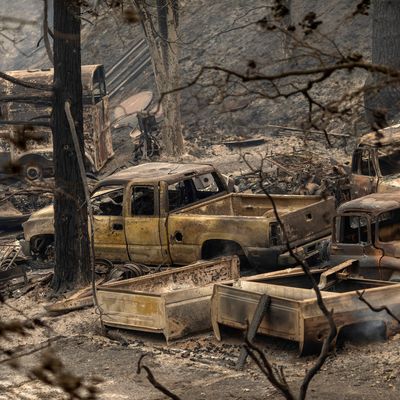
President Trump has reversed a White House–approved rejection of federal disaster aid for California to help the state with the costs of its historic wildfire season. The reason for the initial rejection remains unclear — prompting speculation that the move may have been an attempt by Trump to follow through on his repeated threats to withhold wildfire aid from the state.
On Wednesday, the Trump administration denied California governor Gavin Newsom’s September 28 request for a major disaster declaration for six wildfires that struck the state that month, including the largest individual wildfire in California history, the Creek Fire, which is still burning and has already consumed 344,000 acres in the state’s Central Valley region. All told, the six blazes (which also include the Valley, El Dorado, Slate, Oak, and Bobcat fires) have burned more than 1.8 million acres and incurred more than $229 million in estimated damage. So far this year, more than 8,500 wildfires have consumed more than 4.1 million acres in California, which is roughly 6,400 square miles and twice as much as any other fire season on record. Fighting this year’s wildfires has cost the state an estimated $1.1 billion — at a time when its budget has already incurred a $54 billion blow from the COVID-19 pandemic.
On Friday afternoon, GOP representative Tom McClintock tweeted that House minority leader and fellow California congressman Kevin McCarthy had told him that Trump had agreed to reverse the decision — which the president later did. The White House later said that McCarthy and Newsom “presented a convincing case” for why the state should get the aid.
Federal major disaster declarations allow states to share the costs of damage, cleanup, and rebuilding with the federal government and entitle them to FEMA relief programs. It is not unprecedented for the federal government to deny states’ requests for the declaration, but it’s rare.
The Trump administration’s surprising rejection of Newsom’s request, which California said it would appeal, led to speculation that President Trump was finally following through on his oft-repeated threats to cut the state off after blaming it for the perennial, intensifying, climate-change-fueled fires. Trump, who routinely dismisses the science of climate change and its link to the fires, has repeatedly accused the state of failing to properly manage its forests. In fact, forest management is indeed a critical part of reducing wildfire risk, but California’s wildfires mostly ravage land managed by the federal government, and extreme weather conditions fueled by climate change are the other main factor behind the state’s intensifying wildfire problem.
As to why the state’s September request was denied, officially, California Governor’s Office of Emergency Services spokesperson Brian Ferguson told reporters that he didn’t know why the aid was rejected, and FEMA didn’t respond to requests for an explanation until Friday, when spokeswoman Lizzie Litzow said that “the early September fires were not of such severity and magnitude to exceed the combined capabilities of the state, affected local governments, voluntary agencies, and other responding federal agencies.” (She also said that FEMA had approved lesser aid in five counties affected by the fires.)
White House spokesman Judd Deere later released a statement backing the decision, explaining that California’s request “was not supported by the relevant data that States must provide for approval and the President concurred with the FEMA Administrator’s recommendation.”
But the Trump administration had approved a similar request for aid from the state in response to the wildfires that began in August, which Deere cited in his defense of the administration’s decision. “This summer, President Trump quickly approved wildfire relief for the State of California that was supported by damage estimates. In fact, this week the President made additional disaster assistance available to California by authorizing an increase in the level of Federal funding to 100% for debris removal and emergency protective measures undertaken as a result of the wildfires, beginning August 14, 2020, and continuing.”
Taking the administration at its word, it’s not clear what “relevant data” it found insufficient to support California’s claim, or why the devastating fires, per FEMA’s statement, “were not of such severity and magnitude” to merit a federal disaster declaration.
“I’ve covered wildfires, hurricanes, tornados, drought and blizzards in California, Florida, Maryland, the Southwest & the Deep South. I cannot recall the last time this happened under any administration,” Los Angeles Times reporter Phil Willon noted in a tweet on Friday.
In August, former senior Trump administration official Miles Taylor alleged that the president’s opposition to giving federal aid to California had far more to do with political grievance than forest management — claiming in an anti-Trump campaign video that the president wanted to punish the state for not voting for him. Then again, as the New York Times pointed out Friday, California’s wildfires often strike counties in the state that typically vote Republican. When McCarthy helped convince the president to reverse his administration’s course, perhaps that was one of the points he made.
This post has been updated to include additional information.






























